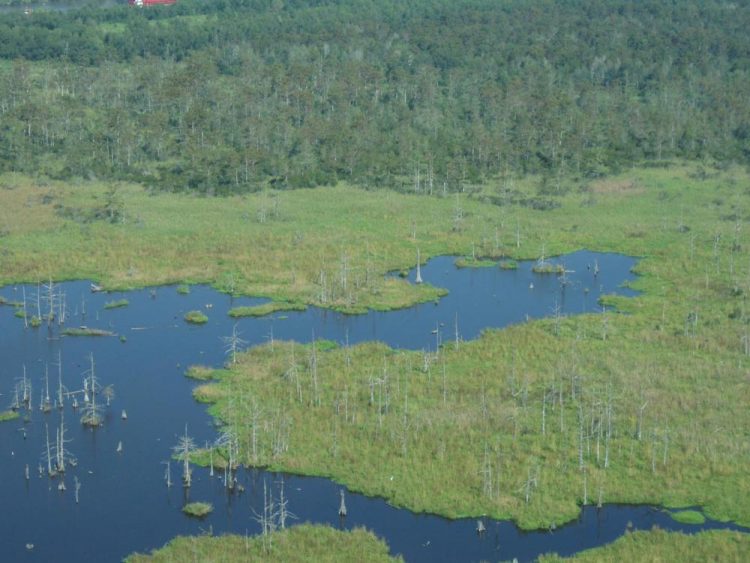Louisiana wetlands struggling with sea-level rise 4 times the global average

A swamp-to-marsh transition near Houma, Louisiana shows dead trees that are most likely the result of saltwater intrusion. Credit: Torbjorn Tornqvist
The study by researchers in Tulane's Department of Earth and Environmental Sciences and published in the open-access journal Nature Communications shows that the rate of sea-level rise in the region over the past six to 10 years amounts to half an inch per year on average.
“In the Mississippi Delta, about 65 percent of study sites are probably still keeping pace, but in the westernmost part of coastal Louisiana, more than 60 percent of sites are on track to drown,” said Tulane geology professor Torbjörn E. Törnqvist, a co-author of the study.
Törnqvist conducted the research with lead author and PhD candidate Krista L. Jankowski and co-author Anjali M. Fernandes, a former postdoc in Törnqvist's group who is now at the University of Connecticut.
The researchers used an unconventional method to measure sea-level change that integrated information from different data sources.
They analyzed measurements of shallow subsidence rates at 274 sites across the coast and combined these with published GPS-measurements of deeper subsidence rates. Adding published satellite observations of the rise of the sea surface in the Gulf of Mexico, they were able to calculate how rapidly sea level is rising with respect to the coastal wetland surface.
“The bottom line is that in order to assess how dire the situation is in Louisiana, this new dataset is a huge step forward compared to anything we've done before,” Törnqvist said.
Justin Lawrence of the National Science Foundation, which provided funding for the study, agreed.
“These researchers have developed a new method of evaluating whether coastal marshes in Louisiana will be submerged by rising sea levels,” Lawrence said. “The findings suggest that a large portion of coastal marshes in Louisiana are vulnerable to present-day sea-level rise. This work may provide an early indication of what is to occur in coastal regions around the world later this century.”
###
The research was made possible through publicly available data collected under the auspices of Louisiana's Coastal Protection and Restoration Authority and the US Geological Survey.
Media Contact
All latest news from the category: Earth Sciences
Earth Sciences (also referred to as Geosciences), which deals with basic issues surrounding our planet, plays a vital role in the area of energy and raw materials supply.
Earth Sciences comprises subjects such as geology, geography, geological informatics, paleontology, mineralogy, petrography, crystallography, geophysics, geodesy, glaciology, cartography, photogrammetry, meteorology and seismology, early-warning systems, earthquake research and polar research.
Newest articles

NASA: Mystery of life’s handedness deepens
The mystery of why life uses molecules with specific orientations has deepened with a NASA-funded discovery that RNA — a key molecule thought to have potentially held the instructions for…

What are the effects of historic lithium mining on water quality?
Study reveals low levels of common contaminants but high levels of other elements in waters associated with an abandoned lithium mine. Lithium ore and mining waste from a historic lithium…

Quantum-inspired design boosts efficiency of heat-to-electricity conversion
Rice engineers take unconventional route to improving thermophotovoltaic systems. Researchers at Rice University have found a new way to improve a key element of thermophotovoltaic (TPV) systems, which convert heat…



